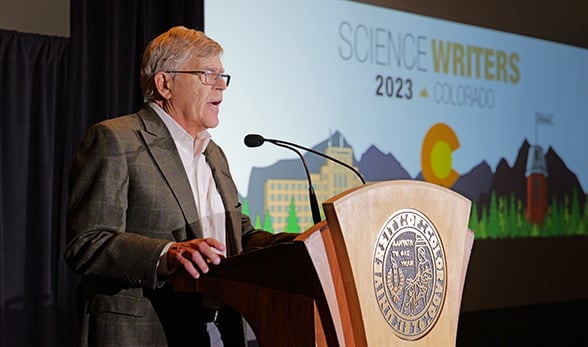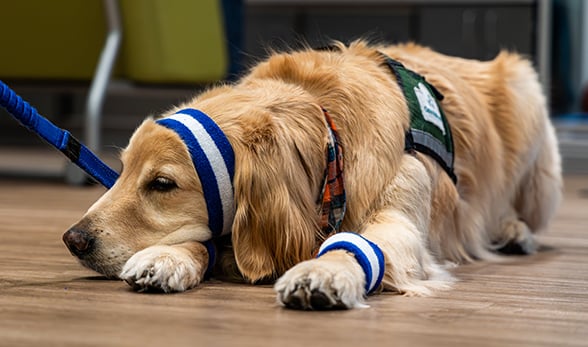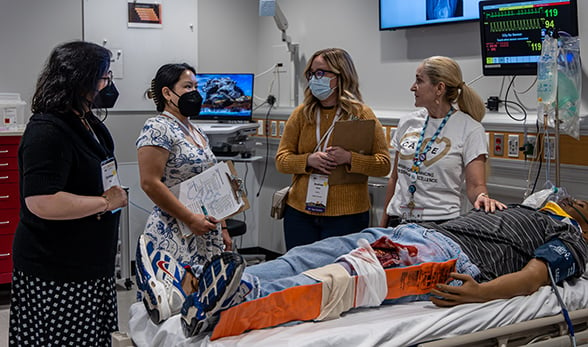Premier conference highlights life-changing science for nation's top journalists
They say the third time's a charm.
If crowded rooms and smiling faces are any indication, the third attempt at hosting the nation's premier science communications conference at the University of Colorado Boulder and CU Anschutz Medical Campus was indeed a charm.
 Chancellor Don Elliman welcomes conference attendees at an opening reception on the CU Boulder campus. |
Delayed not once but twice by COVID-19, ScienceWriters2023 finally made it to Colorado, bringing communicators from across the nation to the state flagship university's campuses. Registrants totaled 871, nearly 700 of those in-person, marking one of the most highly attended conferences in the organizations' history.
"You will find that we have many fascinating stories to tell," said CU Anschutz Chancellor Don Elliman, kicking off the Oct. 6-10 event alongside CU Boulder's Acting Provost Ann Schmiesing, PhD. "As science writers, your work is invaluable for helping to inform and illuminate some of the complex issues facing us today," Elliman told a room packed with journalists from top media outlets from across the country.
Campus hosts: selling inspiration from innovation
A joint meeting of the National Association of Science Writers (NASW) and the Council for the Advancement of Science Writing (CASW), the conference brought journalists together to hone their skills, meet their peers and glean compelling stories from some of the world's top minds in medicine and science at the two CU campuses.
Elliman told the journalists representing media outlets from NPR and Scientific American to The Wall Street Journal and the Associated Press, that he hoped the writers would take inspiration from the innovative work the faculty on both campuses are undertaking.
Conference-goers also included representatives from science foundations, top-tier research universities and federal labs and agencies.
Faculty on the two campuses attracted the majority of the four-campus CU system's $1.46 billion in sponsored research funding and gifts during the 2022 fiscal year, with CU Anschutz at $777.8 million and CU Boulder at $658 million.
 Galaxy (aka, the medical dogtor) takes a break during a tour at Children's Hospital Colorado, where he is a full-time facility dog. |
Through initiatives such as AB Nexus, the two research powerhouses continue to build partnerships working across disciplines and campuses to propel research and uncover answers to vital questions in science and medicine, Elliman said.
Since 2019, joint CU Boulder/CU Anschutz proposals submitted to, and grants awarded by, external sponsors have increased by 40% since 2019, and publications authored jointly by CU Anschutz/CU Boulder faculty have increased by 22%. Opportunities like these build the collaboration and team science essential to speeding discovery and improving human health, Elliman said.
Day offers a glimpse behind the curtain at CU Anschutz
Headquartered at the CU Boulder campus, the event brought about 200 participants to the CU Anschutz on Oct. 8, where they were greeted by Vice Chancellor for Research Thomas Flaig, MD.
"As a researcher myself, I know how important it is to get our findings out into the world, where our discoveries can make an impact on human health," Flaig said. "That's why I'm so grateful to the reporters and science writers like you who are helping the public to make sense of the work that's done in the labs and clinics, so that people can make better-informed decisions for their own health."
 Conference attendees get an interactive tour of the CAPE simulation lab. |
Flaig, a history buff, guided a tour of the Eisenhower Suite in the Fitzsimons Building, where the president lived and performed his duties for a period after suffering a heart attack when the building was an Army hospital.
Other tours included a look at extended reality and medical dogs used to support patients at Children's Hospital Colorado (one of the campuses' two nationally-ranked hospitals along with UCHealth University of Colorado Hospital) and the simulation lab at the Center for Advancing Professional Excellence.
A popular event called Lunch With a Scientist broke conference attendees into more intimate groups, where they were able to talk with some of CU Anschutz's renowned researchers about their studies over a catered meal. Subjects ranged from how nature nurtures fatness to how deep brain stimulation has changed the lives of some patients with obsessive compulsive disorder.
The event serves as the annual meeting for NASW, a 2,600-plus-member organization for people who write or produce content to inform the public about science, and CASW's New Horizons in Science program, in which top-ranked researchers report on seminal advances. Each year, it rotates host campuses among the nation's top research universities.






